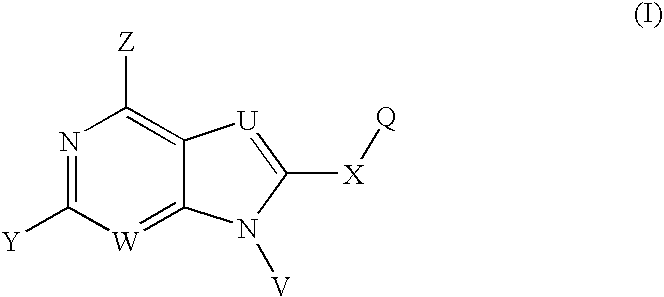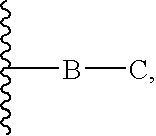HSP90 Inhibitors Containing a Zinc Binding Moiety
a technology of hsp90 inhibitors and zinc binding moiety, which is applied in the direction of heterocyclic compound active ingredients, drug compositions, biocide, etc., can solve the problems of limited ability to use such combinations, increased cost and time, and increased regulatory requirements for demonstrating safety and efficacy of combination therapies. , to achieve the effect of enhancing and unexpected properties of inhibitors
- Summary
- Abstract
- Description
- Claims
- Application Information
AI Technical Summary
Benefits of technology
Problems solved by technology
Method used
Image
Examples
example 1
Preparation of 2-(6-amino-8-(6-bromobenzo[d][1,3]dioxol-5-ylthio)-9H-purin-9-yl)-N-hydroxyacetamide (Compound 1)
Step 1a. 5-Bromo-6-iodobenzo[d][1,3]dioxole (Compound 102)
[0144]A solution of compound 101 (10.0 g, 50.0 mmol), anhydrous acetonitrile (150 mL), TFA (11.4 g, 100.0 mmol) and NIS (33.7 g, 150.0 mmol) was stirred at room temperature for 24 h. The solvent was removed under reduce pressure and the crude purified by column chromatography on silica gel (petroleum) to yield compound 102 as a white solid (18.5 g, 91%): 1H NMR (DMSO-d6) δ 5.99 (s, 2H), 7.10 (s, 1H), 7.26 (s, 1H).
Step 1b. 6-Amino-7H-purine-8(9H)-thione (Compound 104)
[0145]A mixture of 4,5,6-triaminopyfimidine sulfate (50.0 g, 223.0 mmol), NaOH (19.7 g, 493.0 mmol) and water (500 mL) was heated to 80° C. until all the solids dissolved. The solution was cooled to 0˜5° C. and the pH was adjusted to 7.0 with 1N HCl, whereupon the free base crystallized as white needles (27.6 g, 99%). A mixture of 4,5,6-triaminopyrimidin...
example 2
Preparation of 4-(6-amino-8-(6-bromobenzo[d][1,3]dioxol-5-ylthio)-9H-purin-9-yl)-N-hydroxybutanamide (Compound 3)
Step 2a. Ethyl 4-(6-amino-8-(6-bromobenzo[d][1,3]dioxol-5-ylthio)-9H-purin-9-yl)butanoate (Compound 106-3)
[0150]The title compound 106-3 was prepared as a white solid (280 mg, 21.4%) from compound 105 (1.0 g, 2.73 mmol), Cs2CO3 (1.5 g, 4.64 mmol), ethyl 4-bromobutanoate (800 mg, 4.1 mol) using a procedure similar to that described for compound 106-1 (Example 1): LCMS: 480.34 [M]+.
Step 2b. 4-(6-Amino-8-(6-bromobenzo[d][1,3]dioxol-5-ylthio)-9H-purin-9-yl)-N-hydroxybutanamide (Compound 3)
[0151]The title compound 3 was prepared as a white solid (207 mg, 76%) from compound 106-3 (280 mg, 0.58 mmol) and NH2OH solution (1.77M, 5 mL) using a procedure similar to that described for compound 1 (Example 1): m.p. 164.7˜181.0° C., LCMS: 468 [M+1]+; 1H NMR (DMSO-d6) δ 1.93 (s, 4H), 4.14 (t, 2H, J=6.3 Hz), 6.07 (s, 2H), 6.84 (s, 1H), 7.34 (s, 1H), 7.35 (s, 2H), 8.12 (s, 1H), 8.70 (s, 1H...
example 3
Preparation of 5-(6-amino-8-(6-bromobenzo[d][1,3]dioxol-5-ylthio)-9H-purin-9-yl)-N-hydroxypentanamide (Compound 4)
Step 3a. Methyl 5-(6-amino-8-(6-bromobenzo[d][1,3]dioxol-5-ylthio)-9H-purin-9-yl)pentanoate (Compound 106-4)
[0152]The title compound 106-4 was prepared as a pale yellow solid (463 mg, 35.3%) from compound 105 (1.0 g, 2.73 mmol), Cs2CO3 (1.5 g, 4.64 mmol), ethyl 5-bromopentanoate (800 mg, 4.1 mol) using a procedure similar to that described for compound 106-1 (Example 1): LCMS: 480 [M]+.
Step 3b. 5-(6-Amino-8-(6-bromobenzo[d][1,3]dioxol-5-ylthio)-9H-purin-9-yl)-N-hydroxypentanamide (Compound 4)
[0153]The title compound 4 was prepared as a white solid (130 mg, 28%) from compound 106-4 (463 mg, 0.96 mmol) and NH2OH solution (1.77M, 5 mL) using a procedure similar to that described for compound 1 (Example 1): m.p. 191.8˜195.7° C., LCMS: 481[M]+; 1H NMR (DMSO-d6) δ 1.43 (q, 2H, J1=6.9 Hz, J2=14.7 Hz), 1.68 (m, 2H), 1.94 (t, 2H, J=7.5 Hz), 4.14 (t, 2H, J=6.9 Hz)), 6.10 (s, 2H), ...
PUM
| Property | Measurement | Unit |
|---|---|---|
| body weight | aaaaa | aaaaa |
| body weight | aaaaa | aaaaa |
| temperature | aaaaa | aaaaa |
Abstract
Description
Claims
Application Information
 Login to View More
Login to View More - R&D
- Intellectual Property
- Life Sciences
- Materials
- Tech Scout
- Unparalleled Data Quality
- Higher Quality Content
- 60% Fewer Hallucinations
Browse by: Latest US Patents, China's latest patents, Technical Efficacy Thesaurus, Application Domain, Technology Topic, Popular Technical Reports.
© 2025 PatSnap. All rights reserved.Legal|Privacy policy|Modern Slavery Act Transparency Statement|Sitemap|About US| Contact US: help@patsnap.com



